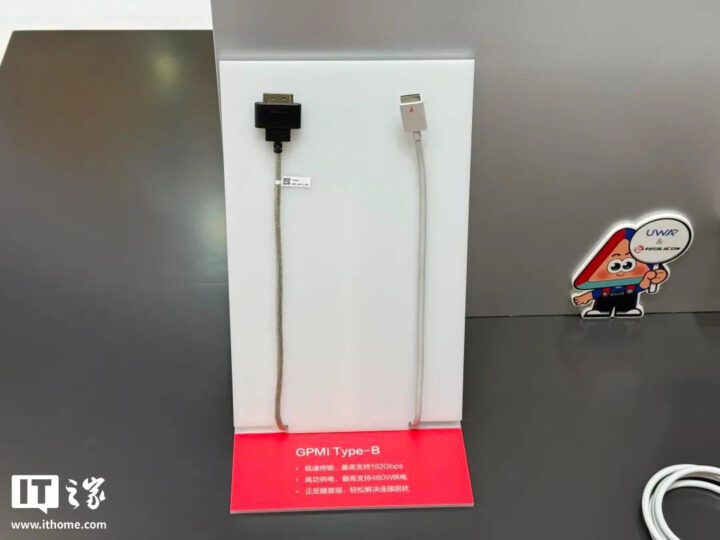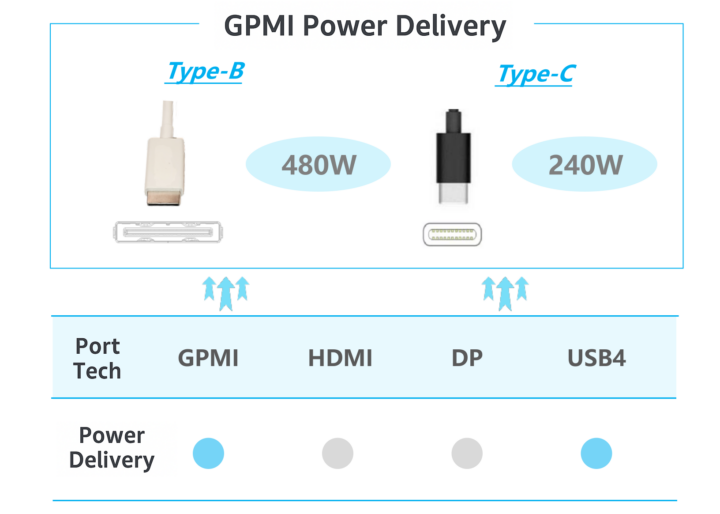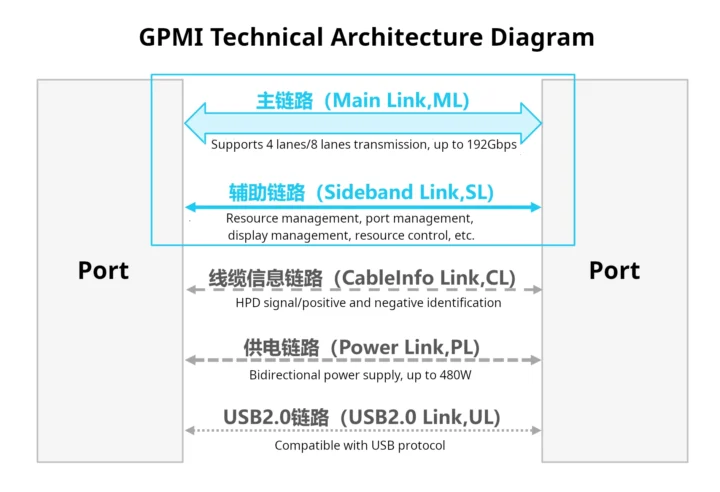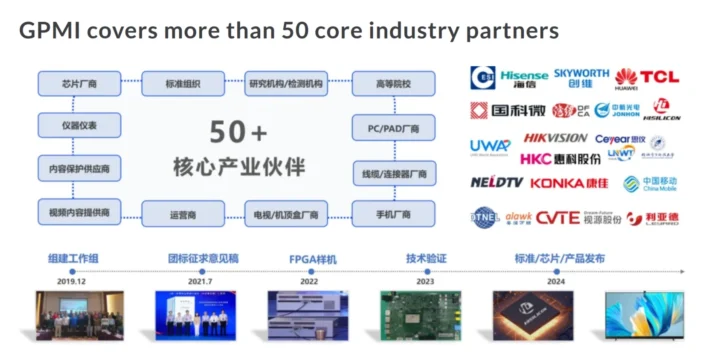Defined by the Shenzhen 8K UHD Video Industry Cooperation Alliance (SUCA), GPMI (General Purpose Media Interface) is an alternative to HDMI and DisplayPort supporting up to 192 Gbps bandwidth and 480W power delivery (PD).
As far as I know, the specifications have not been made public just yet, but ITHome.com shared some photos and details. The GPMI standard defines two types of connectors: Type-B and Type-C (USB-C) with support for 192 Gbps/480W PD and 96 Gbps/240W PD, respectively.

Here’s how GPMI compares to the latest HDMI and DP versions.
| Standard | Speed | Power Delivery |
|---|---|---|
| HDMI 2.1 TMDS | 18 Gbps | N/A |
| HDMI 2.1 FRL | 48 Gbps | N/A |
| DisplayPort 2.1 UHBR20 | 80 Gbps | 240W |
| GPMI Type-C | 96 Gbps | 240W |
| GPMI Type-B | 192 Gbps | 480W |
The best resource I’ve found about the GPMI standard is a white paper shared by Hisilicon. It requires email registration, and it’s only in Chinese, but I’ve translated some of the slides for reference.
The Type-B port looks like a compressed HDMI port, which might be great for laptops and tablets, while the Type-C port appears to be identical to a standard USB-C port. However, I haven’t found the pinout, so it’s unclear whether it’s pin-to-pin compatible, although the diagram below shows USB 2.0 compatibility.
GPMI also implements an alternative to HDCP with ADCP content protection protocol based on SM3 and SM4 “national security algorithms” and much faster than HDMI (200ms vs 2s). The 192 Gbps link can be split into 8 channels, each carrying up to 24 Gbps and configurable as 8+0 (8x Tx @ 192 Gbps, 0x Tx) or alternatives like 7+1 (168/24), 6+2 (144/48), and so on. The standard also supports fast wake-up time, reduced to one quarter of existing standards. The document also mentions an auxiliary link for data transmission of up to 12.5 Mbps, but I’m not sure if it’s related to the Sideband, CableInfo, and Power links shown above, or something else…
GPMI appears to have been unveiled last year at a conference in China according to a post by AOCFiberLink. All 50 companies part of the “Shenzhen 8K UHD Video Industry Cooperation Alliance” appear to be Chinese and include names like HiSilicon, TCL, Konka, Hisense, Skyworth, China Mobile, HIKVision, and others, so it’s unclear whether the GPMI standard will ever gain traction outside of China. HDMI does have a license fee, and it’s unclear whether GPMI will be an open and free standard at this stage.

Jean-Luc started CNX Software in 2010 as a part-time endeavor, before quitting his job as a software engineering manager, and starting to write daily news, and reviews full time later in 2011.
Support CNX Software! Donate via cryptocurrencies, become a Patron on Patreon, or purchase goods on Amazon or Aliexpress








What do we think, 48 Volts, 10 Amps for the Type-B cable?
[ Where’s the power supply?
Is it for the media center, computing unit or for/with/from the peripheral devices? (thx) ]
A compliant TV can power a computer and peripherals, or a computer can power displays and other peripherals attached to it.
I can also see a video wall in the “application scenarios” section of the PDF.
Burn, burn, yes, you’re gonna burn!
Yes, exactly !
Imagine a computer with a couple of these “GPMI” ports. With 3/4 of them you’re close from a professional drill as used to work with concrete (1500/2000w).
Ok, bandwidth is impressive, but the announced power delivery is even more insane.
I really wonder if these numbers can be achieved in a long term use (let’s say a 7d/7d h24 huge digital signage).
[ ~96Gbps is comparable to HDMI2.2 (~96Gbps) and ~16K (15360 x 8640) resolution with 60Hz frequency for display refresh (dynamic?), about 8K (7680 x 4320) 120Hz or 4K (3840 x 2160) 240(/480)Hz. An HDMI (2.1, 2.2?_CES_announced_01/2025) cable for 16K is about $10 for 1-2m. (adapters?) (thx) ]